
All good things must come to an end, and there has never been a better thing in metal than Iron Maiden’s 1980s period. This chapter in our study of Maiden History is a two-part in-depth look at Maiden’s adventures in the late 80s. The first part discusses the turmoil that was the making of Somewhere In Time.
When Iron Maiden started working on their sixth studio album in early 1986 they had successfully completed their manager’s five-year plan of conquering the world, including the all-important North American album and concert market. On the surface all seemed glorious but there was tension and friction behind the scenes, centering on the feelings and ambitions of singer Bruce Dickinson.
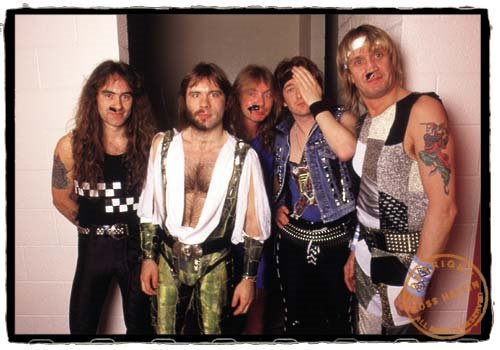
Mad Maiden on the Somewhere In Time tour.
If the above photo illustrates anything, it might be the state of Maiden as they were heading into the final part of their unbeatable 1982-89 classic era. On top of the world, jubilant, proud, fun-loving, but also suffering the sense of lunacy that permeats the daily life of any touring rock band in the biggest league.
BREAKING AMERICA
After the opening salvo of Iron Maiden (1980) and Killers (1981), major changes swept the band. We’ve discussed earlier how the addition of Dickinson and drummer Nicko McBrain saw Maiden really starting to conquer the globe with The Number Of The Beast (1982) and Piece Of Mind (1983):
Dawn of the Classic Era, 1982-83.
Not stopping to catch their breath, Iron Maiden stormed headlong into the height of their classic era with the blockbusters Powerslave (1984) and Live After Death (1985).
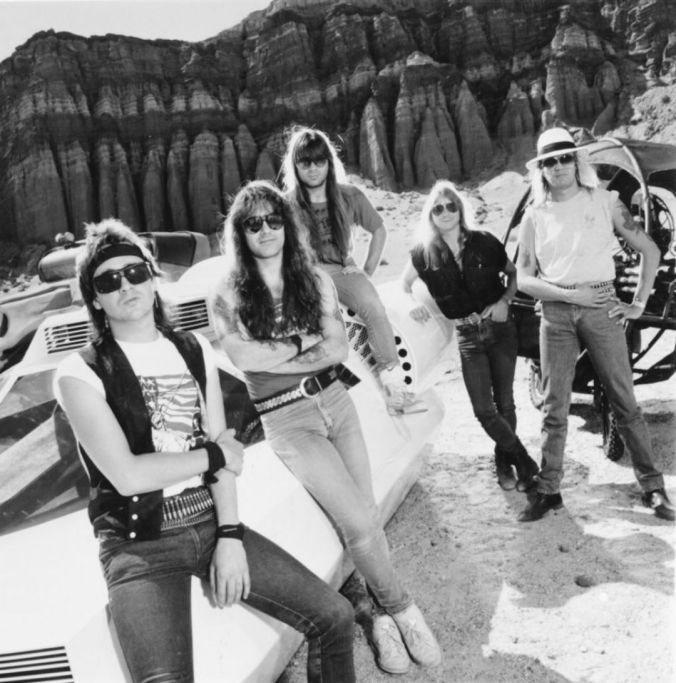
Iron Maiden’s classic line-up photographed in 1986 by Aaron Rapaport, having survived the Powerslave tour and recorded Somewhere In Time: Adrian Smith, Steve Harris, Bruce Dickinson, Dave Murray and Nicko McBrain.
We all know it: Powerslave was HUUUGE, the World Slavery Tour was LOOONG, and Maiden found themselves completely burnt out at the end of 1985. No wonder: 5 studio albums and 1 double live record in less than six years. Factor in a world tour with a massive American leg for every studio album in the 1981-1984 period, and you’ve got manager Rod Smallwood’s five-year plan to build Maiden from nothing to everything in the United States of America. Not that the band didn’t care about the rest of the world, but their schedule was specifically designed to make Maiden big in America.
The pace Maiden set for themselves throughout the 1980s was incredible, and in the end it nearly tore them apart. Band leader and bassist Steve Harris thinks in retrospect that singer Dickinson was particularly fried, being the one who had to run around the stage, singing acrobatically and fronting the band, while selling the proper emotion to go with every epic song the band performed.
“Obviously it’s a tougher gig for him, trying to sing up in that register for two hours every night, five or six nights a week.”
Steve Harris
Dickinson would never have a guitar or a drum set to hide behind, and it seems likely that the band didn’t quite understand how physically and emotionally battered the singer would be after 12 months straight of making thousands of people believe every word every night. All of this without ever pulling an ego stunt and disappearing, but simply delivering on time, come hell or high water. Or in Bruce’s case, even come severe physical illness.
After touring North America as special guests to several big bands on the Killer World Tour in 1981 and Beast On The Road in 1982, Maiden graduated (in many people’s opinion prematurely) to headlining on the World Piece Tour in 1983. The gamble paid off and set Maiden up for a highly anticipated North American headlining trek in 1984-85 on the World Slavery Tour.
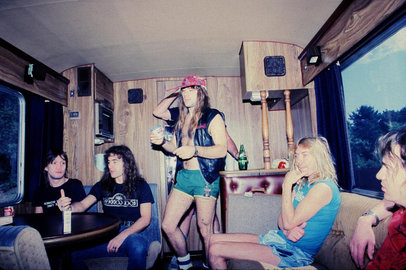
Here’s Iron Maiden bussing through Europe and North America on the World Piece Tour in 1983, but it was the 1984-85 World Slavery Tour that would almost break them. (Note Bruce’s FOUR ARMS DRINKING, a typical syndrome of over-touring.)
SLAVES TO THE POWER
Dickinson claims that the title track for Maiden’s fifth studio album, Powerslave, had slightly tongue-in-cheek lyrics. The band were slaves to the power of the tour at that point. They had become a machine, a hugely successful one. Every year started with the writing and recording of a new album, and morphed into intense globetrotting with a properly hectic concert schedule overseen by manager Smallwood.
“Now you’ll write for six weeks, now you’ll make a record for three months, now you’re rehearsing for two weeks, now you’ll tour for eight months.”
Bruce Dickinson
As Bruce’s addition tells you, Maiden were one month short every year…
When it came to touring, at this point in their career the band might have felt that eight months was a piece of cake. But the World Slavery Tour would get extended, and extended again, for a full year on the road with no significant time off at any point.
The band finally had to tell the manager to put a stop to things in the summer of 1985, or the consequences might be serious. In the 1990s Harris would tell authorized Maiden biographer Mick Wall that, “I thought it would be the last straw, basically, because Bruce was really in a bad way by then. He sort of turned into a hermit when it was over.” And more recently the band leader’s empathy with the singer was just as obvious, even if light-hearted, when he said that, “Two hours of Maiden five nights a week for 12 months – that’s enough to put anyone in the funny farm!”
A sentiment the singer does not dispute:
“I was going stir crazy. Thirteen months on the road was not conducive to the state of my mental health.”
Bruce Dickinson
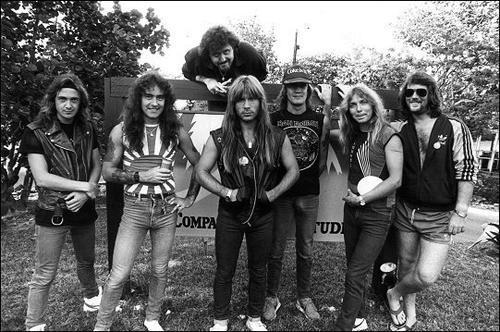
Maiden with producer Martin Birch (in the back) and manager Rod Smallwood (far right) at the beginning of the Powerslave cycle, recording in the Bahamas.
The band had started rehearsals for the Powerslave tour in June 1984, and the tour itself lasted from early August 1984 to early July 1985, bringing the number of months Maiden were on the road without any significant break to nearly 13.
The singer was not the only one in the band who felt a bit bonkers as the tour finally came to an end. Guitarist Adrian Smith remembers that he knocked on the wrong door when he went to visit his parents after the tour’s conclusion! Iron Maiden had reached the top of the world, they had gotten exactly what they wished for, and now they had to deal with it.
“It had just worn everybody out, and at the end we were feeling like we were going through the motions every night, which wasn’t very satisfactory since none of us are people who like faking it.”
Bruce Dickinson
Unsatisfactory ending or not, the peak of the classic era in 1984-85 was a period of unparalleled triumph for Maiden. Their classic line-up established itself as the one to beat, and the ever more impressive guitar partnership of Smith and original guitarist Dave Murray helped take the band’s music into areas of cinematic scope and drama:
Height of the Classic Era, 1984-85.
This mid-classic period culminated with the release of the monumental Live After Death in 1985, as Maiden took a hiatus that was meant to be considerable. “We were supposed to have six months off,” Dickinson would recall to biographer Mick Wall many years later. “Which quickly became four months.”
The five-year plan of album and tour cycles from 1980 to 1985 had ended, and Smallwood set up another five years that would see a year off in 1989 and a fresh start in 1990. Before that came another two massive album and tour cycles, designed to keep Maiden growing in America, but this time the Maiden routine was in danger of leading to an unexpected line-up change.
When Iron Maiden started working towards their sixth studio album in early 1986, the obvious question was: What now?
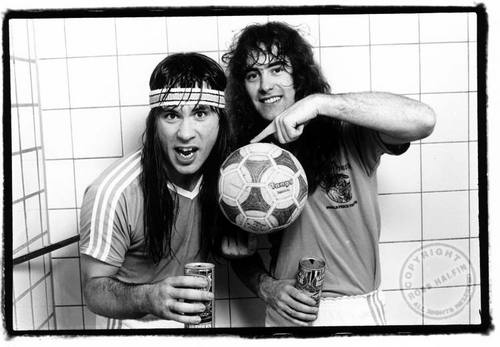
Bruce and Steve had lived through the biggest high of their career with the Powerslave album and tour. But they would have very different ideas about where to go from there…
THE BATTLE FOR DIRECTION
Iron Maiden faced one of rock’s ultimate challenges: No longer the underdog, they had to follow-up a trio of incredible studio records and a hugely successful world tour and live album, with another studio record. There are plenty of bands who crumbled at such a test of their creativity and endurance.
A lot of people would agree that Metallica lost their way when they tried to build on their trio of classic blockbusters: Master Of Puppets (1986), …And Justice For All (1988) and Metallica (1991). The mid-90s follow-ups Load (1996) and Reload (1997) simply paled in comparison. Likewise, it could be argued that Queensrÿche never recovered from their epic world-beaters Operation: Mindcrime (1988) and Empire (1990). And consider KISS, the band that took Maiden on a European tour in 1980, and how they fizzled out of their hugely successful Love Gun / Alive II (1977) period to hit rock bottom with Unmasked (1980) and (Music From) The Elder (1981).
In each case, the band wanted to change.
As did Maiden. And Dickinson in particular. But his state of mind was an issue. Bruce himself admits, in retrospect, that he considered ending his music career at that point, feeling that, “I was just creatively done. Exhausted. Nothing left in the tank really.”
Dickinson’s unauthorised biographer Joe Shooman points out that Bruce’s instinct would always be to rip up the rulebook and chase another challenge. So he envisioned something drastically different for Maiden’s next album.

Exactly THIS crazy was how Bruce felt when he told the band he thought they should do more acoustic music for their 1986 album.
Maiden moved to wintery Jersey in early 1986 to write and rehearse, and then on to sunny Compass Point Studios in Nassau, the Bahamas, as was their routine in the 1980s. For tax purposes, the band would rarely stay in the United Kingdom, spending most of their time on tour around the world and recording abroad.
For the first time in their career, the band decided to take their time with the 1986 project and not rush the process. It seems incredible today, but an album like The Number Of The Beast was recorded and mixed in just five weeks! The 1986 album would take much longer and also include recording and mixing in Wisseloord Studios in Hilversum, Holland and Electric Lady Studios in New York City, USA.
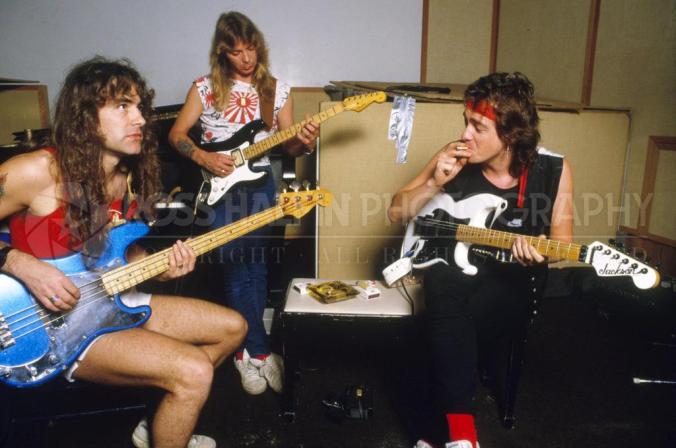
A Ross Halfin shot of Steve Harris, Dave Murray and Adrian Smith making new Maiden music at Compass Point in Nassau in 1986.
According to Dave Murray the band had 6 songs done when they arrived in the Bahamas, and he also reported at the time that, “Steve and Adrian have done the bulk of the writing.” But Maiden fans had grown accustomed to having several Bruce Dickinson tracks on each record. So, where was Bruce’s songs? What had happened on the way to recording?
The band had 3 distinctly separate batches of songs with them. Harris, of course, had several numbers he had worked up on his own, all staying very true to the Maiden sound. Dickinson, on the other hand, came armed with a selection of tunes that made the rest of the band scratch their heads, and Dickinson feeling strange about what might have grown out of the top of his own body:
“I said, you know, we’ve done this big metal thing, should we go a bit more chill-out, maybe we should go a bit more acousticy? And everybody looked at me like I had two heads!”
Bruce Dickinson
Harris admitted later that he thought Dickinson had “lost the plot completely. Bruce just wasn’t himself at the time.” It seems in retrospect that the Maiden chief didn’t quite understand how burnt out the singer was, but he was very clear that the semi-acoustic songs Dickinson brought in were not gonna wind up on a Maiden album. “It was kind of very Jethro Tull-y kind of stuff, which I love,” said Harris many years later. “But it just wasn’t really right.”
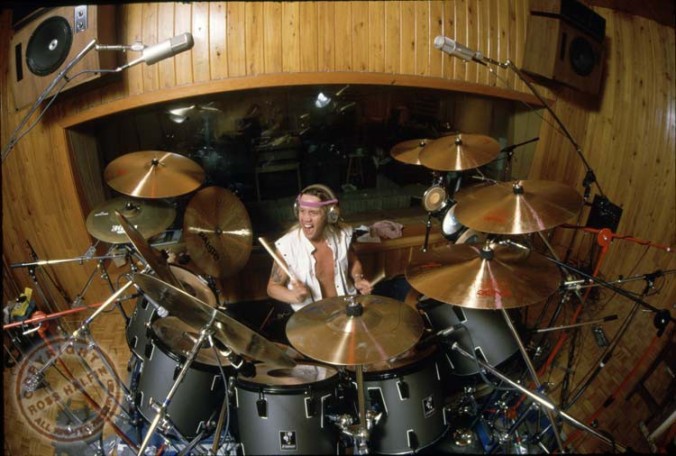
A Ross Halfin shot of Nicko McBrain recording drums for the 1986 Iron Maiden album at Compass Point in Nassau. Definitely not the “chill-out” that Bruce Dickinson had imagined.
Some bands have done what Bruce wanted. Led Zeppelin certainly made it work with Led Zeppelin IV (1971) and Physical Graffiti (1975), the very albums that Bruce wanted to use as templates for Maiden’s own “daring and audacious” adventures, as he later put it to Mick Wall. But what Zeppelin had done was to move far away from their simpler blues-based riff rock origins, and Steve Harris was not prepared to let Maiden abandon the stylistic hallmarks that had made them so incredibly successful in the first half of the 1980s.
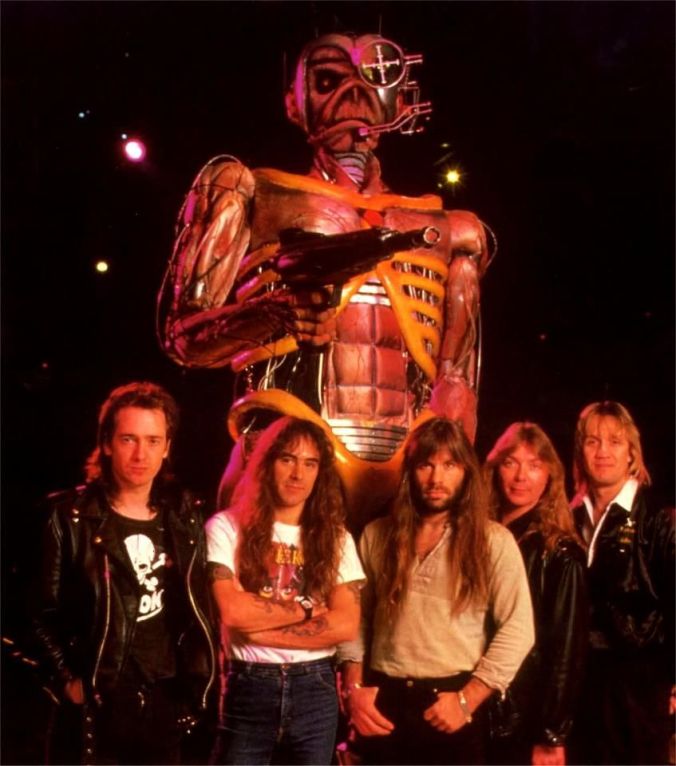
Iron Maiden in 1986-87: An epic battle for the band’s direction took place, with Harris and Dickinson in stern opposition to each other.
Bruce’s vision for late 1980s Iron Maiden was never to be. No one else in the band stood up for him on this one, and Steve would win the battle over Maiden’s direction.
The frontman would later recall with a sense of self-deprecation that, “I remember playing my serenades to Steve. Everybody was in stitches!” And Harris concurred: “The stuff Bruce was coming up with wasn’t us at all. He was away with the fairies, really.”
How to resolve this? Thankfully, the third batch of tunes available, Smith’s bunch, met with everyone’s approval. The Smith songs – Wasted Years, Sea Of Madness and Stranger In A Strange Land – might just be the best on the album, and they would highlight the essential diversity that this line-up of Maiden was capable of.
Some of this was by accident.
Smith was working on ideas in his room in the Jersey hotel where the band wrote songs when Harris knocked on his door, eager to hear something new. “I played a few things, with little reaction,” Smith remembers about guiding Harris through ideas on his tape recorder. Then, unintentionally, he played a descending open-string riff he had discounted and promptly pressed the stop button. “What’s that?”, Harris asked. Smith was afraid it was a bit too commercial for Iron Maiden, but Harris said, “I don’t give a shit about that.”
“That night after dinner, I went back to my room and finished the song Wasted Years. Funny to think if I hadn’t by chance played him the demo, it would never have ended up being a Maiden song.”
Adrian Smith
A Maiden classic was born.
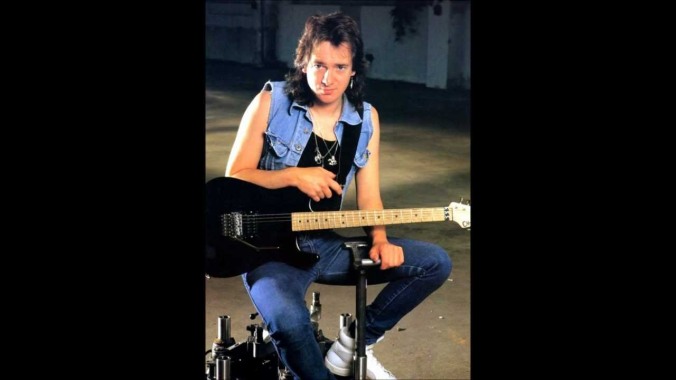
Adrian Smith in 1986, enjoying a slightly different approach to writing Maiden music.
“That’s the beauty of having strong writers in the band. If one’s drying up, you’ve got other people who can take over.”
Steve Harris
Indeed, another firm fan favorite would be Stranger In A Strange Land, which Smith also worked up during the band’s stay in Jersey. The bleak landscapes and stormy weather would conjure up a melancholy tune in Adrian’s mind when his circumstances turned physically painful.
“I was on my way to get a root canal done, and I was on my way back and my face was throbbing, and it was pouring with rain, I was looking out at the sea out of the back window of the cab, and that riff popped right into my mind. And I couldn’t wait to get back to my hotel. We had the whole hotel to ourselves, we had the gear set up and everything, and I worked the riff out and it all went from there.”
Adrian Smith
The lyrics would be inspired by the fascinating real-life story of explorer John Torrington, a member of the mysterious 1845 Sir John Franklin expedition that attempted to find the Northwest Passage from America to Asia. “Preserved in time for all to see,” went Adrian’s lyrics, contemplating the fate of Torrington, whose body was eerily well preserved when exhumed from the ice more than a century later in 1984.
In a recent interview Smith would recall the approach to atmosphere that was important to him in the 1986 writing sessions:
“It was just kind of a very moving story, and it went perfectly with the riff; this kind of desolate, kind of wasteland, and this sense of loss of hope, and it all sort of goes from there. You know, my playing, I like to think, I try and feel stuff, and I like the space to play in it, and that was probably one of the first songs I was able to do that, on that album, because a lot of the Maiden stuff up until then had been very fast, and aggressive, and heavy, but that actually allowed me a little bit of space to stretch out a bit. It was nice, you know. So you’ve got more scope in the writing then.”
Adrian Smith
Maiden had what they needed. Recording could go ahead.
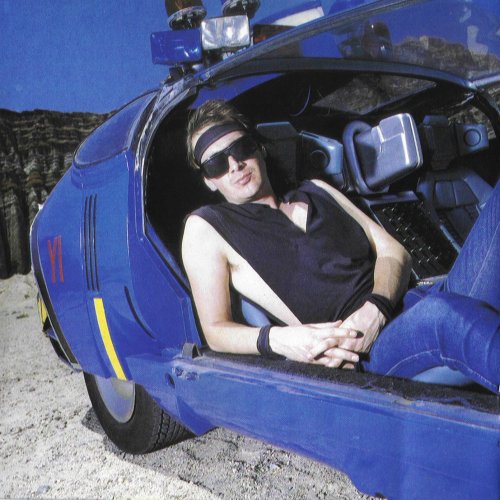
As Bruce Dickinson drifted too far away from Maiden’s proper direction in 1986, Adrian Smith emerged as Steve Harris’ co-pilot through a turbulent time. His songs and playing were fundamentally important to the creation and legacy of Somewhere In Time.
The resulting album would be titled Somewhere In Time (1986) and contained Smith’s three entries, the fast-paced rocker Deja-Vu by Murray and Harris, as well as four more Harris tracks: Caught Somewhere In Time, Heaven Can Wait, The Loneliness Of The Long Distance Runner and Alexander The Great.
Harris would later insist to biographer Wall that the unifying subjects of time and traveling that permeated the new material “was just a way of reading the songs after they were already done. We certainly never went in there and said, ‘Right, let’s write a load of songs on the subject of time.” Of course they didn’t, but Smith would offer a different view:
“If you think about what we’d just done and where we’d just been, maybe it wasn’t so strange that most of the songs we seemed to come up with had something to do with time, either time wasted or time spent learning something that cost you a lot.”
Adrian Smith
Intentional or not, consciously or sub-consciously, the dynamics of Iron Maiden were changing, and the ultimate consequences of their rise to the top were slowly coming into view.
THE COURSE IS SET
The battle for Maiden’s direction that took place in 1986 would have repercussions far into the band’s future. Many seeds were sown, and the three wills were revealed: Those of Harris, Smith and Dickinson.
Harris was intent on staying the course, keeping Maiden recognizable and true to the aesthetic of their previous albums. Smith had always brought a different angle to the songwriting, and would continue to do so with quite free rein. And Dickinson had discovered, and laid bare, a desire to do very different things from what Maiden had going for them under Harris’ leadership.
In many ways, this album project was Adrian Smith’s moment to shine, as first single Wasted Years demonstrates:
Somewhere In Time was a massive watershed in the band’s history, as it brought to light the differences in ambition and personality between Harris and Dickinson. The latter wanted to dream big and take a leap in the dark, while the former rightfully felt that he knew what Maiden was and wanted to stick with it for the long term.
Click here for our review of Somewhere In Time!
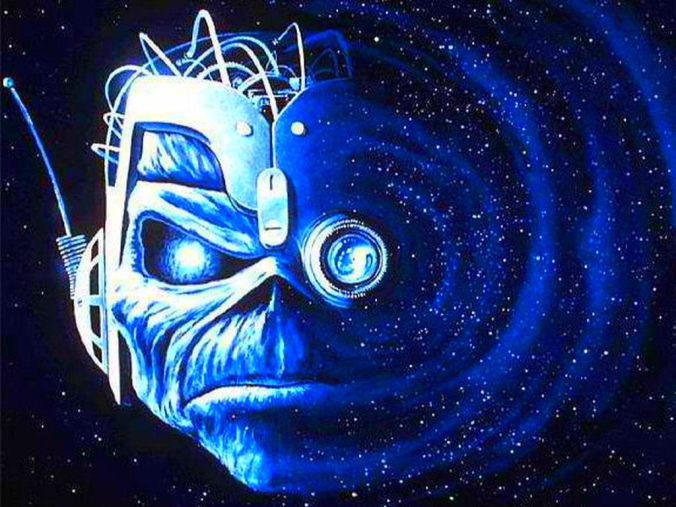
Somewhere In Time would ultimately become a fork in the road for Iron Maiden, the point where a decision about direction was made that would profoundly affect the band’s future. But whatever else happened, band and fans could always trust artist Derek Riggs to deliver the goods.
It’s interesting to note that producer Martin Birch was wary not only of Dickinson’s radical selection, but also of Smith’s entries. He claims that songs like Wasted Years and Stranger In A Strange Land were certainly good, but that they walked the line.
“I always sensed a slight danger of too much input from Bruce and Adrian, because they were always in danger of kind of taking it away from what Maiden really was.”
Martin Birch
The producer points out the single B-side Reach Out, sung by guitarist Smith, as an example of where in the aesthetic landscape he had to put his very experienced producer’s foot down. “To have let the band put something like that on the album would have taken away from the whole point of Iron Maiden.”
As for Dickinson’s songs? Looking back, Birch would be firm in his opinion: “They had to go.”
AFTERMATH
Harris later said, “I could see he would feel bad that his songs were rejected, but he seemed to accept it quite readily at the time.” A dig through the vaults supports Harris’ perception. Fan Club Magazine #17 reported, at the end of the recording sessions in 1986, that Bruce thought the album was the best they had done since The Number Of The Beast and that he thought it was the best his voice had ever sounded…
A couple of years later, Dickinson still sounded close to cheerful about the whole episode, like it was no big deal: “I was talking to Steve about it and even he had a lot of head problems after the Powerslave tour, and nobody had really resolved them by the time we came to do Somewhere In Time. I think I came to terms with it more after we’d done the album.”
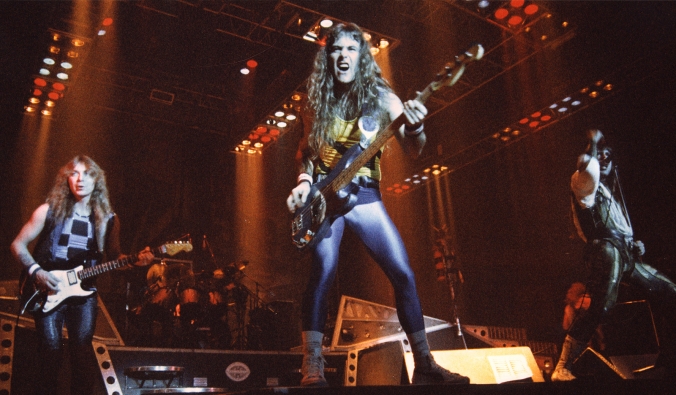
Iron Maiden on tour for the Somewhere In Time album. Bruce’s story about how he felt during this period would change over the years.
When promoting the subsequent Maiden album in 1988, the singer even seemed to think the experience had been a blessing for the band in the long run:
“The relationship between me and Steve gets better and stronger with every album. And probably me not writing anything on the last album made it stronger still. Because in some bands there would be a temper tantrum. […] Obviously my nose was put out of joint a bit, but you have to behave like an adult; people aren’t doing it to spite you, they’re doing it for the good of the band. And that sort of situation just makes the whole unit stronger.”
Bruce Dickinson
There is of course the possibility that this is truly how Dickinson felt about it when it all happened, and that his negative feelings about Somewhere In Time where actually shaped upon entering the 1990s and having trend-minded journalists constantly telling him that Maiden’s late 1980s was a bit crap.
After all, the singer only stated much later that he actually thought about leaving Iron Maiden for the first time in 1986, as a result of feeling rejected. As the band recorded their new music at Compass Point and Wisseloord, Dickinson claimed in retrospect that he felt creatively stifled and had some dark thoughts: “Shall I pack up my toys and go home?”
Smith thinks that this sentiment is overly dramatic, and he quite rightly points out that Dickinson “came in with some songs of his own, and it could have been those that were picked and then I wouldn’t have had anything on there, so I don’t think he can really complain about that.”
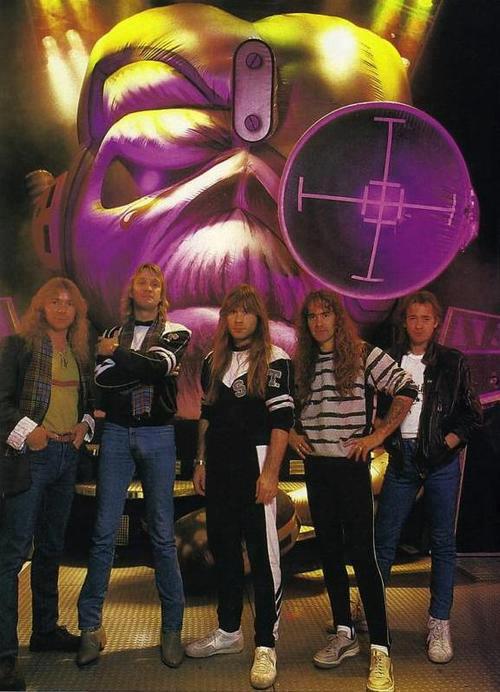
Not the happiest time in Maiden for Bruce Dickinson, coming out of an album project that he didn’t fully believe in, and having to make the audience believe in it every night on tour. Adrian Smith, on the other hand, felt empowered and energized at this point.
Seeds of discontent were sown, and herein lies the catalyst for Bruce’s eventual departure from Iron Maiden in 1993. The ambitious and restless singer would from this point on be chasing other outlets for his energy through solo albums, novel writing, international fencing, and ultimately airplane piloting.
Click here to read about the how and why of all departures from Iron Maiden through the years!
At some point, Maiden would have to give, since Dickinson no longer felt as immersed and connected. As the Somewhere In Time album and tour rolled out in 1986, Dickinson claims he felt “squashed inside for a long time. I felt very much like a fly being swatted.” He resigned himself to just being the singer, he would always perform to the max of his ability and be loyal to the Maiden cause, but his heart was no longer in it the way it had been before. In short, Bruce was disappointed.
“I just felt that we should be leading and not following … That we had to get it onto another level or we’d stagnate and just drift away … We just made another Iron Maiden album.”
Bruce Dickinson
Now, for Maiden fans, “just another Iron Maiden album” might just be the best album in the history of metal, as guest writer Pål Ødegård explains in this homage to Somewhere In Time. The record is consistently popular with fans, and it quickly became Maiden’s first and only double platinum seller in the United States.
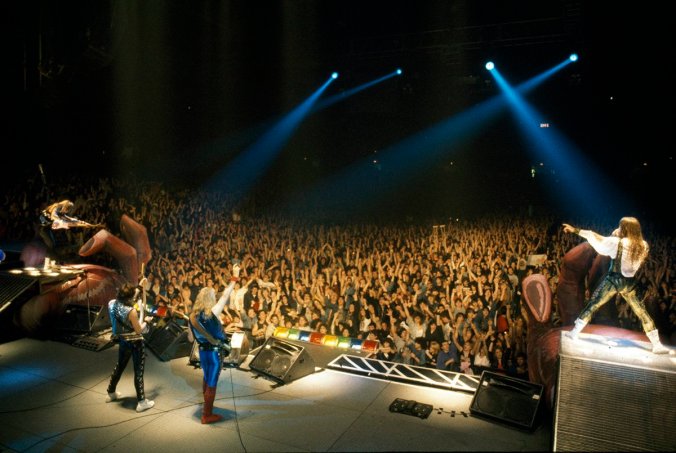
Dickinson might not have been impressed with his own band’s latest album, but Maiden’s fans made sure Somewhere In Time was a big seller and the tour a great success.
Indeed, over time the fans would come to resent Dickinson’s negative attitude towards what is undoubtedly one of the most popular Iron Maiden albums ever. And with time, pun absolutely intended, the singer’s disappointment would also seem to abate.
But Dickinson’s intentions for Maiden back then were clear, whether one agrees with him or not. The diverging notions of direction within the band in 1986 were massive. It was a time and place for finding purpose, and in retrospect it was the friction between the three wills, the three different senses of direction, that formed Iron Maiden in their late classic era and ultimately beyond.
After struggling through the birth of their latest album, it was time for Maiden to get back on the road.
SOMEWHERE BACK ON TOUR
Trying to learn from their past mistakes, Maiden vowed not to over-tour this time. So, as manager Smallwood says, tongue-in-cheek, “This one was only 157 shows.”
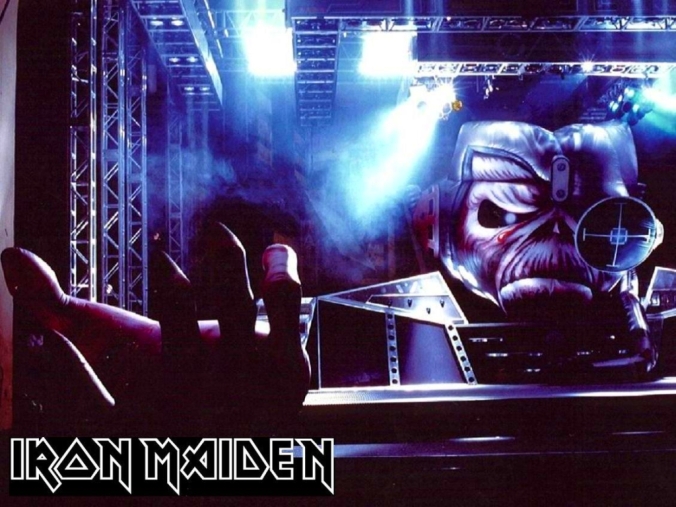
Eddie awaits the band on the Somewhere On Tour stage set.
Indeed, Maiden tours would still be huge, but there would be more days off in-between gigs, and thus more time for Dickinson to rest and for all band member’s to pursue outside activities that would keep them sane. It was probably crucial, as the singer changed his mind about leaving.
“We got to the end of that tour, and I thought ‘Oh, that wasn’t too bad!’, had a little think about things…”
Bruce Dickinson
As it turns out, Dickinson would be much more in tune with Harris for the next album project. But the tour they had undertaken on their way to that point, cunningly titled Somewhere On Tour, would be a bit of a black hole in the preservation of Maiden history.
As songs from Somewhere In Time have been lamentably absent from Maiden’s sets since then, with the now-and-then exceptions of Wasted Years and singalong romp Heaven Can Wait, so would the 1986-87 tour pass undocumented except for the footage in the Stranger In A Strange Land promo video:
Often derided by the band for Spinal Tap-ishness, the Somewhere In Time show nonetheless is unique in the pantheon of Maiden stage productions. Maiden Revelations have celebrated its inventive and unique designs and effects in this BEST & WORST feature about Maiden’s 1980s stage shows.
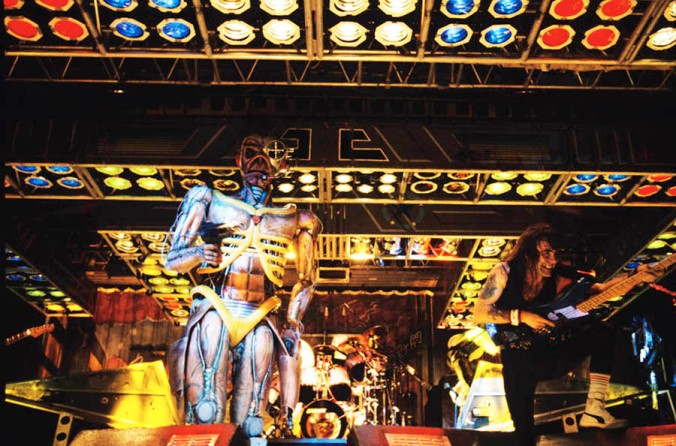
Cyborg Eddie and Steve Harris Somewhere On Tour.
But the band’s memories seem to center on the problems of Eddie’s inflatable head and his equally inflatable hands, which caused many dramatic moments to turn into comic relief. “This was the ‘Great Inflatable’ tour,” remembers Bruce. “Dave Lights was still doing our lighting stuff, and he had a bit of an inflatable megalomania, in fact.”
Steve would have close encounters with these problems.
“Me and Bruce stood in the palms of the inflatable hands. On one night a lamp was too close and burnt a hole in it. Consequently it was like [makes deflating noise] … I felt a right plonker being up there like that.”
Steve Harris
In any case, there was never a concert film from this tour. Harris regrets not filming the show properly, but manager Smallwood admits he “thought it was a bit too soon after Live After Death.” What exists in the band’s vaults now are bits of it but no full record.
“I really wanted to film that tour, and Rod went ‘No, we’re not bloody filming this tour’, and we’ve regretted it ever since.”
Steve Harris
For lack of any official live concert from the 1986-87 world tour, fans have to make do with bootlegs. One of the better ones, covering the show with a single camera and taking the sound off the board, is this recording of the Paris show on 29 November 1986:
In 1999, upon his return to Iron Maiden, Dickinson stated that he and Harris had simply agreed to disagree about Somewhere In Time. With so much else from the golden age to focus on, this probably made sense as a peacekeeping device. But one can always ponder what might have been, as guest writer Adam Hansen does in this previous feature.
In 1986 the band presented a united front, and Harris’ remarks at the time would indicate either a white lie or him not being aware of Dickinson’s feelings: “I honestly think this must be the first time we’ve ever done an album where we’ve all come out at the end and all felt happy about all the songs.” This was some way from the thruth, and Harris himself would be more critical of the album in retrospect.
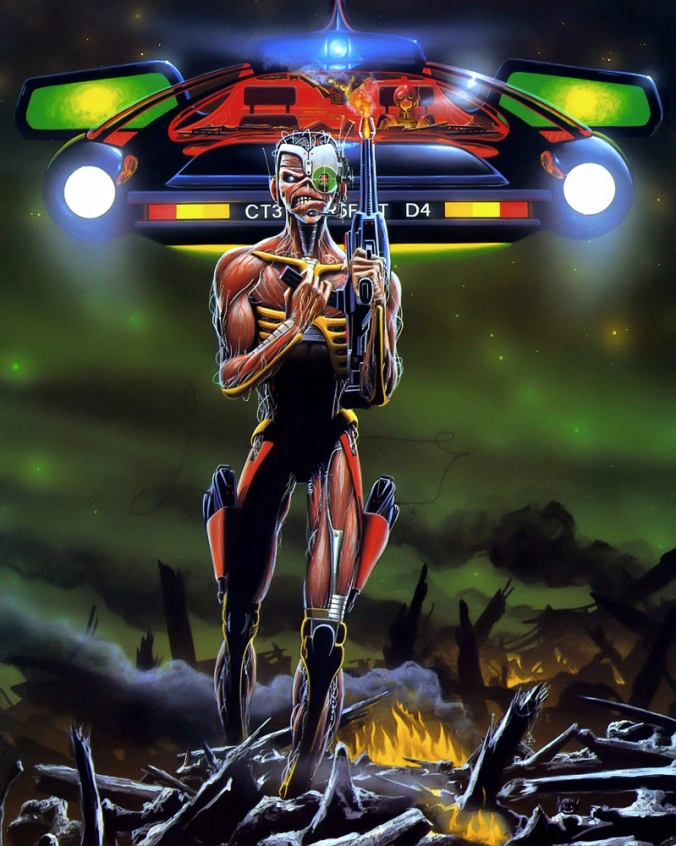
The continuing adventures of Cyborg Eddie in Derek Riggs’ artwork for Somewhere On Tour.
The differences of opinion about Somewhere In Time within the band is possibly why the album never got the same spotlight in later years as the other classic era albums did. Of all the 1980s albums, it is the one that is most ignored in setlists, even in the reunion era that have brought numerous history and legacy (some would say nostalgia) tours that have reanimated underplayed tracks.
It might be harder to understand why songs from Piece Of Mind have been underplayed, with the exception of The Trooper and Revelations, since everyone in the band loves that particular album. But for fans, Somewhere In Time is probably the most glaring omission as we pass the year 2020.
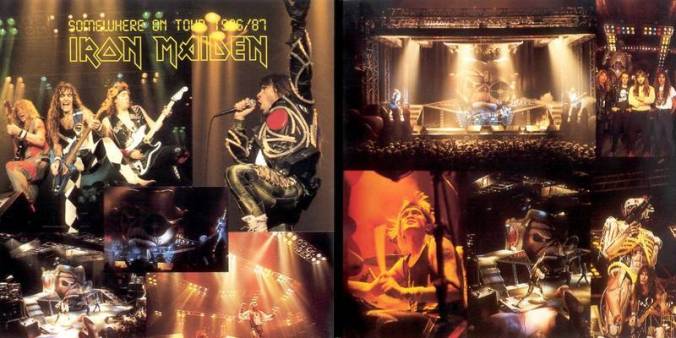
1986-87 live action. Not captured on film or tape, never granted an official release of any sort, beyond the Stranger In A Strange Land promo video.
By the summer of 1987 the Somewhere In Time era was behind them, and Iron Maiden could take stock.
For all of the trials and tribulations of 1986-87, things turned out just fine. Maiden cemented their position as one of the most productive and successful metal bands ever, they delivered one of their best-loved albums, kept growing in the US by selling double platinum, Dickinson decided to stay in the band, and everything looked to be on an even keel.
They would soon turn their attention to studio album number seven:
End of the Classic Era part 2, 1988-89.
Sources: Fan Club Magazine #16 (1986), Fan Club Magazine #17 (1986), Uncredited interview logged at MaidenFans.com (1988), Stockholm, Sunday April 28 1996 (bookofhours.net, 1996), Run To The Hills: The Authorised Biography of Iron Maiden (Mick Wall, [1998] 2001), Bruce Dickinson: Flashing Metal With Iron Maiden and Flying Solo (Joe Shooman, 2007), Classic Rock‘s “Iron Maiden: Hope and Glory” (Paul Elliott, 25 May 2011), Metal Hammer (April 2013), The History of Iron Maiden, Part 3: Maiden England (DVD, 2013), Kerrang!: “Maiden Heaven” (2014), What Does This Button Do? (Bruce Dickinson, 2017), Classic Rock Platinum Series and Metal Hammer present “Iron Maiden” (Edited by Dave Everley, 2019), Adrian Smith Interview With Eon Music (Eamon O’Neill, 2020), Monsters of River & Rock: My Life as Iron Maiden’s Compulsive Angler (Adrian Smith, 2020).
Great article! Very in-depth and there were some bits and pieces I didn’t know before, so from a fan’s point of view, extremely interesting stuff. Lots of Maiden revelations indeed.
Cheers!
Thanks for the kind words, Rantsu! The article has now been updated with some more info that people might not have been aware of. 🙂
One thing id have mentioned is how little the SIT songs have been played live over the decades. Only really Heaven Can Wait and only really since Smith rejoined, Wasted Years. I never understood why Stranger was never a staple in the set. Alexander is phenomenal. The title track would have made a change from opening with Aces on history tours. Why did the band ignore this record over & over?
That’s why we linked this feature by Adam Hansen into the article.
But surely, they only opened with Aces on one of the history tours, to be fair. And they couldn’t possibly have picked a different opener for that particular tour.
Thanks, great article.